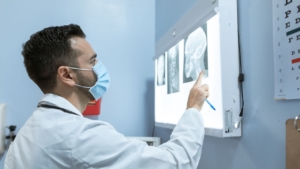Key Takeaways
- AI is revolutionizing medical imaging by enhancing diagnostic accuracy and speed.
- Portable imaging devices are increasing accessibility to diagnostics in remote areas.
- Cloud-based platforms are transforming how medical images are stored and shared globally.
- 3D and 4D imaging are advancing diagnostic precision in key fields like oncology and cardiology.
- AI-assisted predictive analytics is enabling earlier detection and personalized treatment plans in healthcare.
Are you curious about what’s next in the world of medical imaging? The year 2024 promises to be a groundbreaking year for the industry, with exciting advancements and innovations that will shape the future of healthcare. From artificial intelligence to portable devices, medical imaging is evolving rapidly.
In this blog, we’ll explore the top five trends that will define the future of medical imaging equipment and provide valuable insights from Spectrum Medical Imaging Co., a trusted medical imaging equipment distributor and medical imaging products supplier with over 40 years of industry expertise.
1. Artificial Intelligence and Deep Learning Integration
Artificial intelligence (AI) is no longer a futuristic concept in healthcare—it’s here, and it’s transforming the way we diagnose and treat patients. AI and deep learning are revolutionizing diagnostic imaging by allowing machines to analyze medical images faster and more accurately than human clinicians. AI tools can detect patterns in imaging scans that might be missed, improving early diagnosis, particularly in complex fields like oncology and neurology.
Spectrum X-Ray insights suggest that AI-driven solutions will not only enhance diagnostic accuracy but also reduce the time required for image interpretation. Leading companies like GE Healthcare and Siemens Healthineers are already incorporating AI into their imaging devices, pushing the envelope of healthcare innovation.
2. Portable Imaging Devices Gaining Traction
One of the most significant trends is the rise of portable medical imaging devices. These compact, easy-to-use machines are transforming the accessibility of diagnostic tools, especially in rural or underserved areas.
Portable devices like handheld ultrasound machines or mobile X-ray units are making it easier for healthcare professionals to bring diagnostics to patients, instead of the other way around.
As a medical imaging products supplier, Spectrum Medical Imaging Co. offers state-of-the-art portable imaging systems, ideal for mobile clinics, home care, and emergency settings. The convenience of these devices means faster diagnoses and treatments, especially for critical cases where time is of the essence. Portable imaging solutions are paving the way for more decentralized healthcare, making it possible to deliver top-quality care anywhere.
3. Cloud-Based Image Storage and Data Sharing
Cloud computing has been a game-changer across many industries, and medical imaging is no exception. Cloud-based image storage and sharing systems like PACS (Picture Archiving and Communication Systems) are becoming increasingly essential for healthcare providers. These systems allow medical professionals to access imaging data from anywhere
By leveraging the cloud, healthcare professionals can make faster, more informed decisions, particularly in emergency situations where rapid data access is critical.
4. 3D and 4D Imaging Advancements
Three-dimensional (3D) and four-dimensional (4D) imaging technologies are set to make a massive impact in 2024. While 3D imaging has been around for a while, advancements in hardware and software are pushing it to new heights, offering more detailed and lifelike representations of internal structures. Meanwhile, 4D imaging, which adds the element of time to 3D models, is gaining popularity in fields like obstetrics and cardiology.
As a leading medical imaging equipment distributor, Spectrum Medical Imaging Co. has seen increased demand for 3D and 4D imaging technologies. These advancements not only improve diagnostic accuracy but also enhance patient experience by providing more comprehensive views of their conditions.
Patients can now see highly detailed, dynamic representations of their body structures, allowing for better understanding and engagement with their treatment plans.
5. AI-Assisted Predictive Analytics
AI isn’t just helping with diagnostics—it’s also revolutionizing the way healthcare professionals predict and prevent disease. AI-assisted predictive analytics allows for the analysis of massive datasets, identifying patterns that may indicate the onset of diseases before symptoms even appear.
Spectrum Medical Imaging Co., as a trusted medical imaging products supplier, recognizes the potential of AI in predictive healthcare. With advancements in imaging technologies and data analytics, clinicians can leverage imaging data to make more accurate predictions about patient health, tailoring treatments to individual needs.
The future of medical imaging will be about not just diagnosing disease but preventing it altogether.
New Medical Imaging Equipment
When it comes to new medical imaging equipment, several innovations are shaping the future of diagnostic healthcare. Here are some of the latest breakthroughs in the field:
- AI-Powered Imaging Systems: AI integration is transforming imaging devices like MRI, CT, and X-ray machines, allowing for faster and more accurate diagnostics. Companies like GE Healthcare and Siemens Healthineers are leading the way with AI-driven software that assists radiologists in interpreting images more precisely.
- Portable Imaging Devices: Portable ultrasound and mobile X-ray machines are becoming increasingly important in emergency care and rural settings. These devices are lightweight, easy to use, and allow healthcare providers to conduct scans on-site without the need for large imaging centers.
- 3D and 4D Imaging: Advancements in 3D and 4D technology have made medical imaging even more detailed and dynamic. 3D imaging is widely used in oncology for tumor visualization, while 4D imaging is beneficial in cardiology and obstetrics for real-time visualization of the heart or a fetus.
- Spectral CT Scanners: These new CT machines use multi-energy sources to provide more detailed images by differentiating between tissue types based on their chemical composition. This technology is particularly useful for identifying cancerous tissues or evaluating vascular conditions.
- Digital PET/CT Scanners: The latest PET/CT scanners offer higher resolution imaging, allowing for more precise tumor localization and disease staging, particularly in oncology. This fusion of positron emission tomography (PET) with computed tomography (CT) is providing doctors with sharper, clearer images to improve diagnostic accuracy.
These innovations represent the future of medical imaging and are essential for improving patient care through faster, more accurate diagnostics and more accessible healthcare services.
Why Spectrum Medical Imaging Co. is Your Trusted Partner for 2024 and Beyond
With over 40 years of experience as a premier medical imaging equipment distributor, Spectrum Medical Imaging Co. is committed to staying at the forefront of healthcare innovation.
Whether you’re looking to upgrade your current imaging systems or explore the latest in portable and cloud-based technologies, Spectrum Medical Imaging Co. has the expertise and products to meet your needs.Ready to equip your healthcare facility with the latest in medical imaging? Contact Spectrum Medical Imaging Co. today for cutting-edge solutions!




